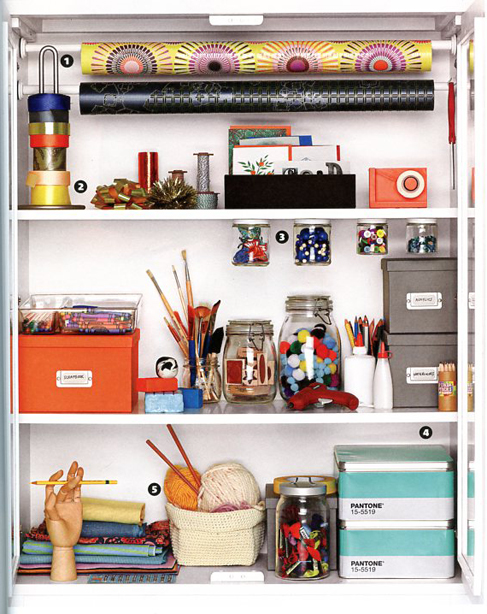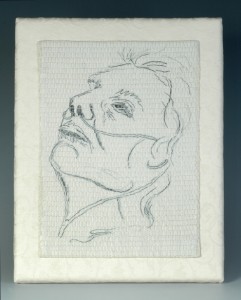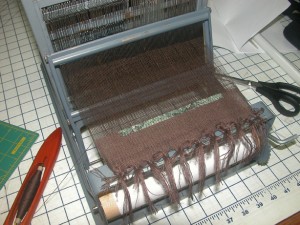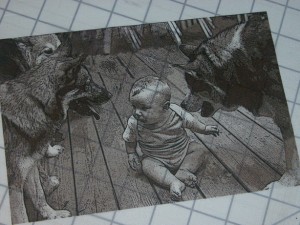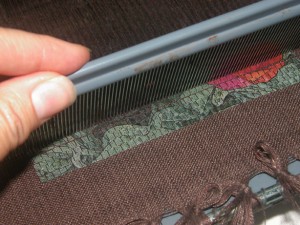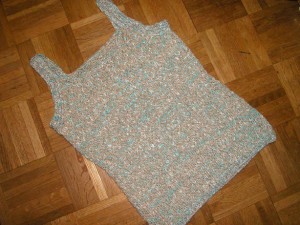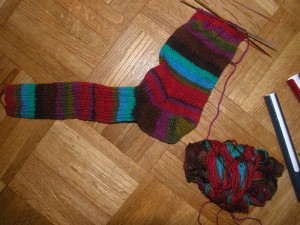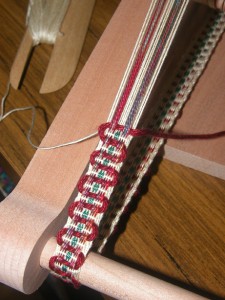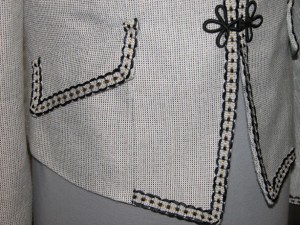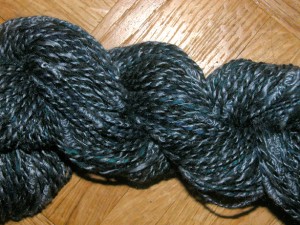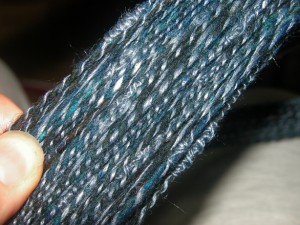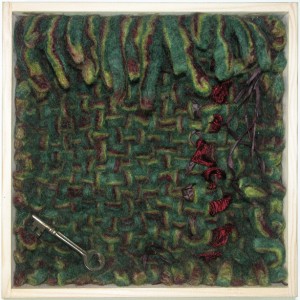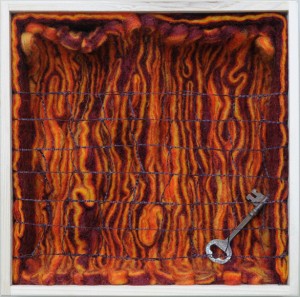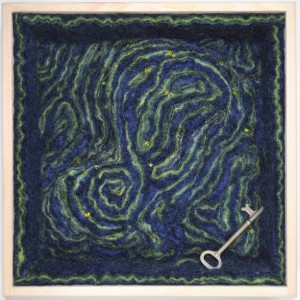With DARYL LANCASTER
 WEAVE YOUR OWN TRIM ON THE INKLE LOOM
WEAVE YOUR OWN TRIM ON THE INKLE LOOM
Thursday, October 13, 2011
9:00am – 12:00 noon
Class Fee: $75.00
Class Size: 15 students
No weaving experience necessary! The inkle loom is portable, easy to warp, easy to weave off, and makes beautiful belts and bands. Daryl uses it to trim her garments. Every weaver should own one. They are inexpensive and children as young as third grade can learn to use them. Come learn this simple warp face structure, looms are available. Participants should be able to finish a small bookmark.
Optional $10. Loom rental
PLEASE NOTE: PARTICIPANTS IN THIS CLASS MAY NOT USE THE SAME LOOM/WARP FOR THE ADVANCED CLASS.
Students should bring:
• 3 Colors of 3/2 or 5/2 Cotton, at least 50 yards of each. The more contrast the colors have, the better. (If using skeins of Perle Cotton from DMC, available at local craft stores, please unskein them and wrap the yarns on a card before coming to class)
• Scissors
• Tape Measure
• If you own an inkle loom and would like to use it, feel free to bring it along. Please no inkle looms with warp and cloth beams like the Gilmore and the Glimakra. They require specific equipment for warping and this class does not focus on beaming chain warps.
• If you are bringing your own inkle loom, don’t forget to bring a small belt shuttle, like a stick shuttle except with a more tapered edge along one side.
A full color 37 page bound handout is included in class fee. Material for heddles will be provided if you already have a loom and it does not have heddles.
Please let me know if you will need to rent an inkle loom for the class,theweaver@weaversew.com
THE FEE FOR LOOM RENTAL IS NOT INCLUDED IN THE CLASS FEE AND WILL BE COLLECTED BY THE INSTRUCTOR.
PLEASE NOTE: PARTICIPANTS IN THE MORNING INKLE LOOM CLASS WILL NOT BE ABLE TO USE THE SAME LOOM/WARP IN THIS ADVANCED CLASS. THANK YOU.
To register online click here.
To print and mail your registration click here.
ADVANCED INKLE LOOM WEAVING
Thursday, October 13, 2011
1:00pm – 4:00pm
Class Fee: $75.00
Class Size: 15 students
PLEASE NOTE: PARTICIPANTS IN THE MORNING INKLE LOOM CLASS WILL NOT BE ABLE TO USE THE SAME LOOM/WARP IN THIS ADVANCED CLASS. THANK YOU.
For those who are looking for the next step with this simple two shaft loom, this is the class for you. Come with a pre-warped inkle loom using a pre-assigned draft and learn 1/1 name draft pick-up, standard 7 thread pick-up, and a supplemental warp technique. (Note: students cannot take the morning class and use the same loom for this one.)
If you are bringing your own inkle loom, don’t forget to bring a small belt shuttle, like a stick shuttle except with a more tapered edge along one side.
STUDENT MATERIALS LIST:
o Each student should bring a pre-warped inkle loom, following the provided draft. The size of the yarns is important.
o Scissors
o Belt or Band shuttle (like a stick shuttle but with a knife edge on one long side)
o A small 10” long bungee cord for holding the supplemental warp out of the way.
o Small amounts of your warp threads in case of breakage.
o Extra heddles or heddle thread. (Note: since the warp threads will be fine -10/2 cotton, you may want to consider making finer heddles, 3 cord crochet cotton can work here.)
o A sheet of graph paper and a couple of colored pencils.

There are three yarns in this draft, the colors you pick should be vibrant and high contrast. The “blue” yarn in the above draft should be equivalent to a 10/2 cotton. The “white” yarn in the above draft should be equivalent to a 5/2 cotton and should be in HIGH CONTRAST to the “blue” yarn.
The “blue” yarn will be the shuttle or weft thread as well.
The “red” yarn in the above draft should be a mid value hue, and be equivalent to a 10/2 cotton. The “red” yarn will be the base for the supplemental warp.
For the supplemental warp, please bring a larger grist yarn, this can be something interesting, a fatter knitting yarn, it can be variegated, or decorative. This yarn should be larger in diameter than a 3/2 cotton. Bring a couple of choices. You will need approximately 5 yards of this yarn. We will add it later.
If you are using a Schacht type inkle loom, the length of the warp may be once around the perimeter of the loom, approximately 64”.
If you are using a smaller Ashford Inklette, set up the loom to have at least 60” in warp length.
The finished width of the band, if using the recommended yarns, will be 1 ½”. Please note, this width is pushing the maximum of the smaller Inklette, if you have a larger inkle loom available, you might want to consider using that one for this workshop.
Please start your warp with the first thread on the upper left of the draft. This first warp thread will be over the top peg of the loom and will get a heddle.
It is important to follow the draft exactly and to check it carefully. There must be 15 “white” threads in between the “blue” threads on the left side of the draft, in order to correctly do the name draft. The center “red” section should have enough threads to create a sufficient ground for the supplemental warp which will be added later.
The seven “white” threads in the section on the right, must each sit between two “blue” threads in order to do a seven thread pick up.
Any questions, feel free to email me, Daryl at theweaver@weaversew.com or call 973 628-0185
To register online click here.
To print and mail your registration click here.
KITCHEN DYEING WITH KOOL AID® AND OTHER FOOD BASED TREATS
Friday October 14, 2011
9:00 am – 12:00 Noon
Class Fee – $ 75.00
Class Size – 20 Students
If it has food coloring in it, it can dye wool! Have some fun dyeing skeins of wool and raw fleece, with simple safe food products in the microwave oven. Participants will play with mixing dyes, and leave with a couple of colorful examples. Examples may be used in the afternoon speed tapestry weaving class. All ages. Fee Includes Dyes and Wool.
To register online click here.
To print and mail your registration click here.
SPEED TAPESTRY WEAVING
Friday October 14, 2011
1:00 pm – 4:30 pm
Class Fee – $ 75.00
Class Size – 20 Students
Fee includes: Roving and Yarns, handout
Think tapestry weaving is slow? Try this subtractive method, great for all ages, using a simple frame tapestry loom, and some wool roving, magically create a woven base for colorful yarns and textures in fun pile techniques. Bring a landscape photo for inspiration if you wish. Take home a finished miniature tapestry! All ages.
To register online click here.
To print and mail your registration click here.
FIBER TO FABRIC
Saturday October 15, 2011
9:00 am – 10:00/10:30 am
Class Fee – $ 30.00
Class Size – 30 Students
From the back of the sheep to finished fabric, this remarkable process will fascinate all ages. Starting with a sheep fleece, explore carding and spinning on a drop spindle, and spinning on a spinning wheel. Then it is onto the loom! Different types of looms will demonstrated. A great way to understand the entire process, perfect for all ages.
To register online click here.
To print and mail your registration click here.
WEAVING: THE OLDEST CRAFT?
Saturday October 15, 2011
1:00 pm – 2:00/2:30 pm
Class Fee – $ 30.00
Class Size – 30 Students
An extremely varied craft, weaving takes on many forms and purposes. We start with an interactive discussion of how weaving impacts our lives today. Samples of looms, from backstrap to contemporary shaft loom, are shown or demonstrated. Samples of finished products are used to show the many forms weaving can take. All ages.
To register online click here.
To print and mail your registration click here.
BOBBIN LACEMAKING
Saturday October 15, 2011
2:30 pm – 3:30/4:00 pm
Class Fee – $ 30.00
Class Size – 30 Students
All ages will enjoy this very old fiber technique, beautiful and impressive even as it is being executed, lace pillows, bobbins, lace examples, and lace history are all covered. A great link to world history and geography for older kids! Beginning stitches are demonstrated and depending on class size and time, a few participants can try this fascinating craft. All ages
To register online click here.
To print and mail your registration click here.
GREAT GARMENTS FROM HANDWOVEN CLOTH
Sunday October 16, 2011
9:00 am – 10:30 am
Class Fee – $ 30.00
Class Size – 30 Students
Color handout of the presentation.
Using PowerPoint and samples, Daryl Lancaster will be presenting a lecture covering sett choices, finishing fabric, color and inspiration, and basic techniques for sewing with handwoven fabrics. It is a whirlwind lecture, hold on to your seats! All levels.
To register online click here.
To print and mail your registration click here.
“THOU SHALT WASH THY FABRIC WHEN IT COMES OFF THE LOOM” and other basic principles of handweaving.
Sunday October 16, 2011
10:30 am – 12:00 Noon
Class Fee – $ 30.00
Class Size – 30 Students
Explore the possibilities of handwoven yardage; fiber, texture, sett, how much to weave, sampling and finishing will be covered. Think of the washing machine and/or dryer as a critical part of the design “team”. Learn how to sample on the actual yardage. Lots of ‘before’ and ‘after’ samples to explore. All levels.
To register online click here.
To print and mail your registration click here.
INLAID TRANSPARENCY: THE MOORMAN TECHNIQUE
Sunday October 16, 2011
1:00 pm – 2:30 pm
Class Fee – $ 30.00
Class Size – 30 Students
Color handout of the presentation.
Explore the tapestry technique highlighted in Theo Moorman’s book, Weaving as an Art Form. This simple technique of inlay on a plain weave ground can be done on any basic 4 shaft loom. Daryl uses this technique for her current body of artwork. PowerPoint presentation. All levels.
To register online click here.
To print and mail your registration click here.
 Speaking of organizing, I nearly wet myself from laughing so hard when I came across this article in Real Simple magazine. Real Simple is probably the only non textile magazine I subscribe to other than Time or Newsweek, largely because I am inspired by the food. The article is called Micro Organizing, and there are a number of “I Spy” like photos that show junk drawers that have been converted to organized little compartments. They all look wonderful in the photos, but realistically, the time spent on this kind of task would be disproportionate to how long the contents would stay in that state, at least in this household.
Speaking of organizing, I nearly wet myself from laughing so hard when I came across this article in Real Simple magazine. Real Simple is probably the only non textile magazine I subscribe to other than Time or Newsweek, largely because I am inspired by the food. The article is called Micro Organizing, and there are a number of “I Spy” like photos that show junk drawers that have been converted to organized little compartments. They all look wonderful in the photos, but realistically, the time spent on this kind of task would be disproportionate to how long the contents would stay in that state, at least in this household.